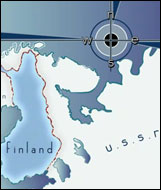

The War Slows Down
After the initial phases of Finnish advance, the warfare on the Finn-Soviet front became very static. The Soviets were engaged elsewhere in their fight against the Germans and the Finns began to strengthen their positions. On January 1, 1942, there was a Soviet attack on the Maaselkä Isthmus that at first has some success, but the Finns are able to regain control by the January 21. There was another Red Army attack in April on the Svir, River which turned into a Finnish rout. This victory was so complete that the German 163rd Division was able to leave the Svir River area and return to Lapland. The Island of Suursaari, in the Gulf of Finland, was attacked by the Soviets and lost by the Finns, but control was regained by March. In June, Mannerheim celebrated his 75th birthday, which included a visit from Hitler, secure in knowing that for the time being the Finns were in control of their front. Mannerheim was also named Marshal of Finland in this same time frame.
On June 28, an order was given for an armored division to be formed at Petrozavodsk, known as the Lagus Division, named after its commanding officer. For the rest of 1942 there were no large actions on the Finnish front lines. The biggest problems the Finns faced were Russian “partisan” soldiers being dropped behind the Finnish lines, as these soldiers were causing a fair amount of damage to Finnish inter- structure at least on a local scale. In this same time frame, the Finns increase their long range patrols at times crossing deep into Soviet territory. The Finns made use of this downtime in the fighting to strengthen their positions by building more trenches, bunkers and minefields on the front lines. In 1941 the Finns lost about 450 men per day in the fighting (killed or wounded) while in 1942 this number dropped to under 60, which shows how much the war had slowed down on this front. In December, Von Ribbentrop sent a note to Helsinki expressing some concerns that Finland might pursue a separate peace with the Soviet Union as he and Hitler were worried about Finnish inaction on the front lines.
 Finnish
soldiers working on trench systems during the lull in the fighting.
Finnish
soldiers working on trench systems during the lull in the fighting.
Brent Snodgrass





